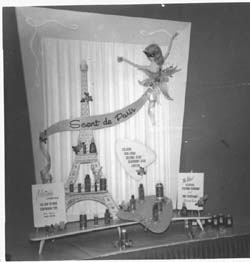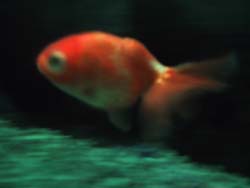Peripheral vision

I found this charming old picture in a box of junk, its original provenance long forgotten
It has an aura of lightness and optimism that seems almost archaic now.
The winged sprite, with her impish black mask flitting around a paper Eiffel tower, has doubtlessly long ago disintegrated into dust. The photographer who took the picture, the person who fabricated the cheerful display and the customers (who jauntily dabbed Scent de Paris behind their ears and onto their bosoms) are likewise all (probably) dead.
Were they happy?
Did Scent de Paris infuse them with ‘jouissance’?
Sometimes, when things move forward, they can no longer go back.
A diode works that way. Current can only flow through a diode in one direction. It’s an interesting property of semiconductors. Old style diodes were sometimes called ‘valves’ for that reason.
The human life is like a diode, through which time can only flow in one direction.
Yet we try to achieve our goals. We are a goal obsessed society and are encouraged to stay “goal oriented” and “focussed.” The following of tangents is not encouraged, even though in the greater scheme of things, it is these tangents that can be the key to our survival. Tangent following is a basic mechanism of evolution.
Sometimes the things most worth looking at, just creep in at the side of our gaze. That’s the problem with focus – you miss a lot of interesting stuff.
Night vision is a case in point. In order to see better at night, you have to train your eyes to go crosseyed. In fact there are people who train themselves to develop their night vision to get into a kind of altered state.
Their website contains this reference to The Book of Five Rings, in which:
The Book of Five Rings, Miyamoto Musashi, the legendary swordsman of 16th century Japan, implies that he fought his greatest duels with his eyes crossed, and goes into considerable detail about developing and using this strange ability. He writes somewhat mysteriously about a state he entered while so engaged. He also refers to the two types of sight which he calls Ken and Kan. Ken registers the movements of surface phenomena; it’s the observation of superficial appearance. Kan is the examination of the essence of things, seeing through or into. For Musashi, Ken is seeing with the eyes, Kan is seeing with the mind, a difference paralleling that between style and substance. He gives instructions for developing Kan sight: “It is important to observe both sides without moving the eyes. It is no good trying to learn this kind of thing in great haste. Always be watchful in this manner and under no circumstances alter your point of concentration.”
The nightwalkers say that :
The whole secret to mastering peripheral awareness is keeping one’s visual attention independent from focused vision.
Plone has been in my peripheral awareness for quite some time now, as a way to organize the documentation of my work and to interact with the communites that exist around it. I have been resisting creating an internet accessible archive for years now, mostly because I haven’t found a comfortable platform in which it can exist. I need to disseminate but also to facilitate the creation of an interactive community *all within the context of the site*. I have started building my Plone site, which has vaulted me into a whole new universe of learning. I am taking baby steps towards learning the vicissitudes of Zope and OSX’s ‘terminal’ program and will be uploading my prototype site to a plone-friendly server shortly.
I’ve also been helping take care of an advanced Alzheimer’s patient (my mother-in-law) for a while now, which has got me thinking a lot about memory. While we tend to think of memory as the domain of higher life forms, BBC World recently broadcast an item about the amazing memory of fishes.

According to this report:
Now, fish are regarded as steeped in social intelligence, pursuing Machiavellian strategies of manipulation, punishment and reconciliation, exhibiting stable cultural traditions, and co-operating to inspect predators and catch food.
apparently:
“fish (are) the most ancient of the major vertebrate groups, giving them “ample time” to evolve complex, adaptable and diverse behaviour patterns that (rival) those of other vertebrates. These developments warrant a re-appraisal of the behavioural flexibility of fishes, and highlight the need for a deeper understanding of the learning processes that underpin the newly recognised behavioural and social sophistication of this taxon.”
Which leads me to wonder:
Maybe we are short-changing *many* other life forms by underestimating their intelligence. While they may have a relatively small number of nodes in their neural nets, the level of connectivity between nodes is probably pretty high. Also with creatures like fish that live in schools or swarms, each individual is a node connected to many other individuals creating a giant component or giant cluster, very quickly. Linked by chemical trails or (in the case of fish) lateral lines, schools of fish can respond en masse (and in an instant), to minor disturbances in the water.
The closest I have ever come to this experience (or rather its human equivalent) was standing in the middle of Tokyo’s Shinjuku Eki (train station) at rush hour. Shinjuku Eki handles 3 million passengers a day. Standing in the midst of a vast corridor seething with humanity, I was dazed by the spectacle but *not a single person bumped into me.*



